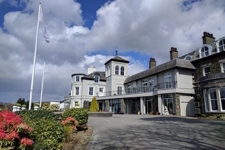Bowness-on-Windermere

Bowness on Windermere City Centre
(villorejo / Shutterstock.com)
Though they are considered two separate towns with separate town centres, Windermere, and its smaller neighbour Bowness-On-Windermere, have grown together to become one moderately sized urban settlement on the eastern edge of Lake Windermere.
Together, with a combined population of around 12,000, the two towns have become the Lake District’s most popular tourist destination, thanks to their accessibility and the number of high profile attractions in the area.
Top Windermere Hotels
Windermere is undoubtedly the Lake District's most popular holiday destination, so it should come as no surprise that there are ample options when it comes to accommodation in Windermere. Whether you're after a luxury lakeside retreat or just something simple to use as your base, you are spoilt for choice in Windermere. Here are our top suggestions for Windermere.
History
Originally a small fishing village, the older town of Bowness dates back to the 15th century when the parish church St Martin’s was constructed. The arrival of the railway line in 1847 bringing a flock of Victorian tourists to the area resulted in the creation of Windermere town and the expansion of Bowness.
Victorian architecture is prominent in both of the two towns, and thanks to the boating services available from Bowness the area has maintained its position as a tourist destination for over 150 years.
Shopping
Though it can be hard to determine where Windermere finishes and Bowness begins, both towns do have distinctive high streets. Windermere has a number of outdoor shops and is home to the flagship Lakeland shop selling a range of kitchen, home, and garden goods.
Bowness has a great deal more shops, with a long high street that stretches down to the lakeshore. Here you will find a few well known high street brands interspersed with art galleries, antique shops, independent gift shops, and local artisan food producers.
Key Attractions

Boat on Lake Windermere (JuliusKielaitis / Shutterstock.com)
England’s largest natural lake, Windermere, is the main draw of Bowness and Windermere. From the shores of the lake in Bowness you can take a car ferry over to the small town of Hawkshead, hire a boat, or take a cruise.
If you are feeling energetic, the Windermere Way is a 45-mile path that takes you around the whole of the lake. Orrest Head is a popular fell walk for beginners, with an easy route that starts at the railway station and spectacular views from the summit.
Children will delight in the wonderful World of Beatrix Potter in Bowness, where Peter Rabbit and his friends are brought to life in a magical world of 3D scenes. Outside there is a delightful garden where herbs, plants, and vegetables that were popular in Potter’s time are grown. Adults will find Blackwell House, a celebration of the Arts and Crafts movement, intriguing, with its extensive collection of artwork, furniture, and artefacts. The house is located just south of Bowness.
Getting There
By Car – Exit the M6 at junction 36 and take the A590 and then A591 that is signposted for Windermere and Keswick. Whilst there are a number of car parks available in both Windermere and Bowness, as well as on street parking, it can be difficult to find a space during peak periods.
By Public Transport – Rail services operate between Oxenholme and Windermere station, with connections onto the West Coast Mainline from Oxenholme. Bowness is around a 20-minute walk from Windermere station. There are also regular bus services from Kendal and Barrow to Windermere, as well as services from Penrith during the summer months.



